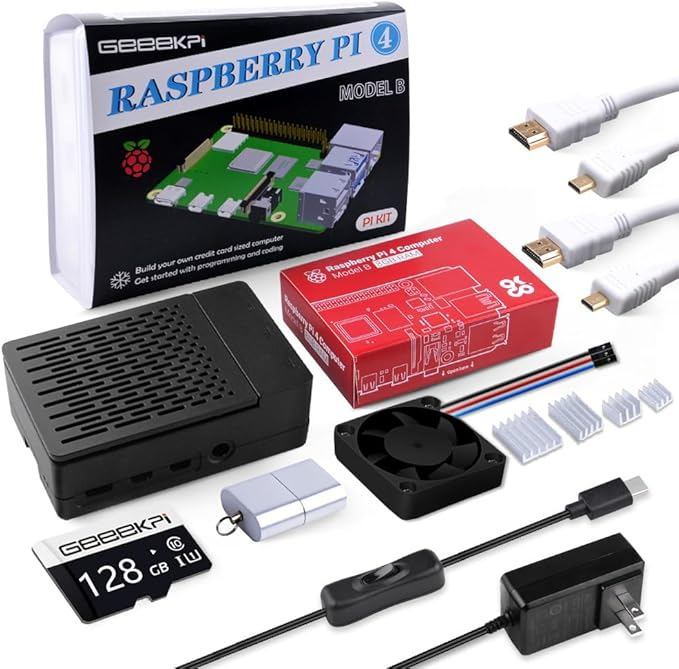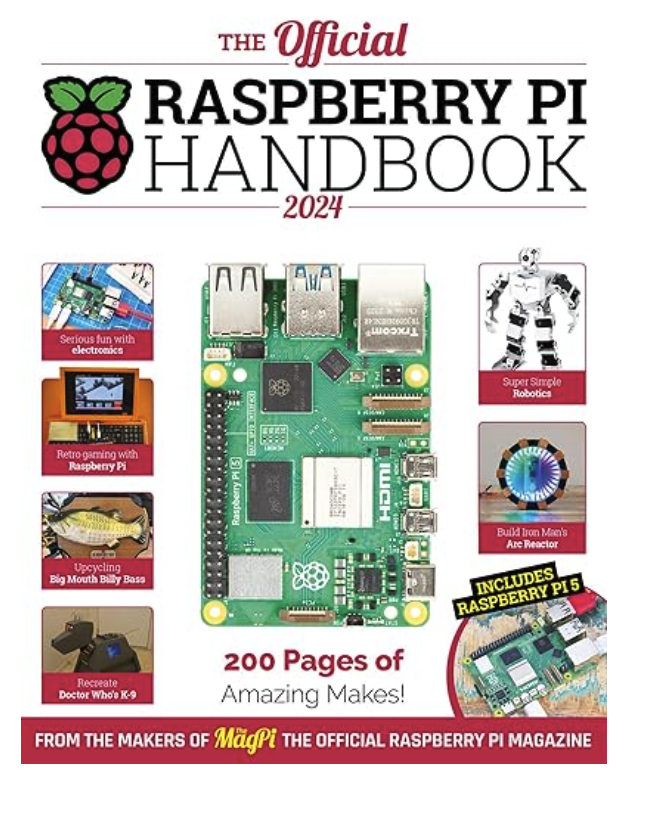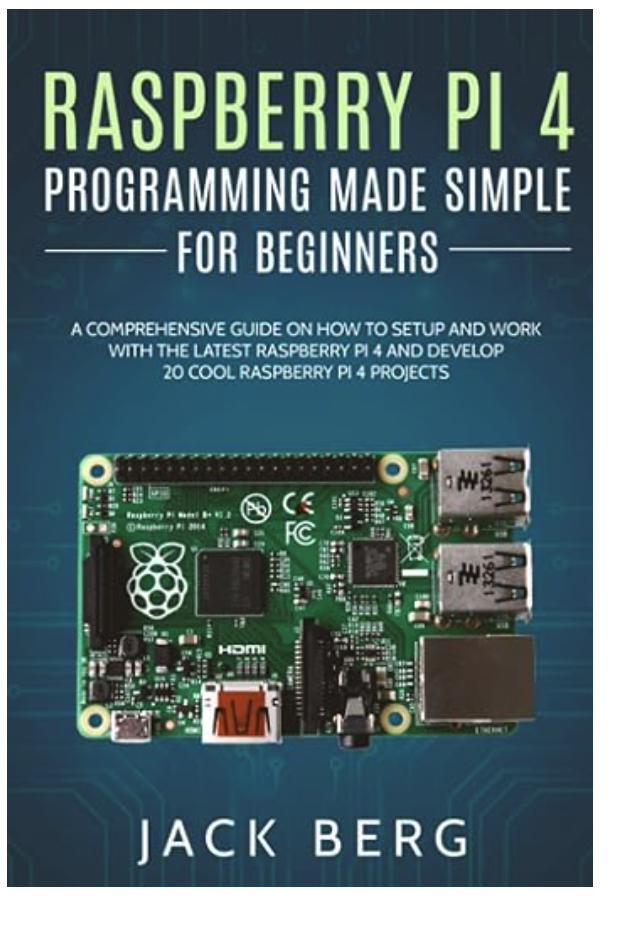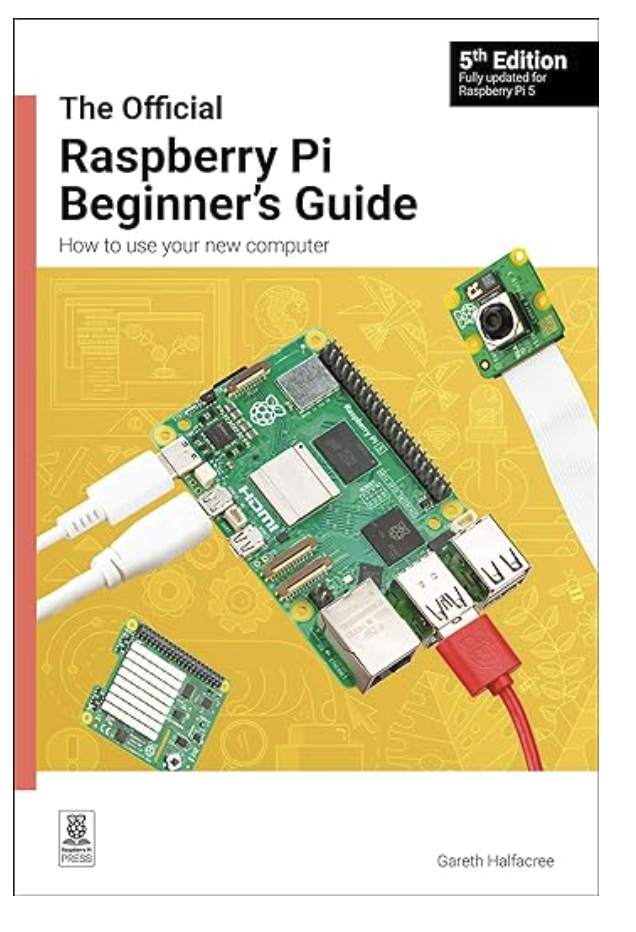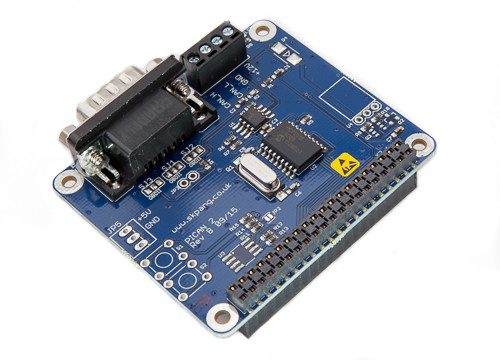Blog
Recent Posts
Discover the Basics of the Raspberry Pi Along with Projects
Posted by on
The Raspberry Pi Starter Kit includes the Raspberry Pi 4 8GB Model B with a 1.5GHz 64-bit quad-core CPU and 8GB of RAM. The case is equipped with a super quiet 40mm PWM fan and four heat sinks to ensure good heat dissipation for the Raspberry Pi. Additionally, it comes with a 5V 3.6A Type C power supply featuring an ON/OFF switch to simplify your Pi's operation.
The package includes the Raspberry Pi 4B (8GB RAM), a Raspberry Pi 4B case, a cooling fan, four aluminum heatsinks, a 5VDC 3.6A power supply, a 128GB SD card (with card reader), and two 4K HDMI cables. More Information...
The Official Raspberry Pi Handbook 2024
The Official Raspberry Pi Handbook 2024 is brimming with essential information for beginners to get started with their new Raspberry Pi computer. Additionally, it features the top projects from the previous year for dedicated Raspberry Pi enthusiasts.
Discover the latest features of the Raspberry Pi 5 in our special section, where you can learn to code and create amazing projects with this powerful microcomputer. Additionally, we offer numerous tutorials and projects for the Raspberry Pi Pico and Pico W, the smallest members of the Raspberry Pi family.
We have included a variety of projects involving the Raspberry Pi 4, the Raspberry Pi Zero 2 W, and the Raspberry Pi Pico W in these 200 pages. Find the latest reviews, tutorials, project showcases, guides, and more. This is your ultimate resource for all things Raspberry Pi! More Information...
Raspberry Pi 4 Programming Made Simple for Beginners
Whether you are new to programming or would like a small, efficient computer or server to assist with your business or other personal computer-related functions, then chances are that you’ve been interested in Raspberry Pi 4.
The Raspberry Pi has become incredibly popular among computer hobbyists and businesses for a variety of reasons. It consumes very little power, is portable, has solid-state storage, makes no noise, and offers extension capabilities, all at a very low price.
Amateur tech enthusiasts use Pi boards for various purposes, such as file servers, media centers, routers, retro game consoles, and network-level ad blockers. This is just a tiny sample of what you can do with this device, as you can start with hundreds of projects.
The Raspberry Pi 4 is a faster version, so you can imagine how fun it would be to have such a small computer decoding 4K video, making faster network connections, and enjoying faster storage through USB 3.0. Did you know that this Pi also supports two screens at once? Raspberry Pi is indeed great, but Raspberry Pi 4 is something else. More Information...
The Official Raspberry Pi Beginner's Guide
The Raspberry Pi is a small, clever, British-built computer packed with potential. It's made using a desktop-class, energy-efficient processor and is designed to help you learn coding, discover how computers work, and build your own amazing things. This book was written to show you just how easy it is to get started.
This updated edition covers the latest Raspberry Pi models, including Raspberry Pi 5, Raspberry Pi Zero 2 W, and the newest Raspberry Pi OS. It also features a new chapter on the Raspberry Pi Pico!
Whether you have a standard Raspberry Pi board, the compact Raspberry Pi Zero 2 W, or the Raspberry Pi 400 with an integrated keyboard, this affordable computer can be used for learning coding, building robots, and creating all sorts of interesting projects. If you're interested in making games, building robots, or working on a variety of amazing projects, then this book is here to help you get started. More Information...
PiCAN 2 - CAN Bus Interface for Raspberry Pi
This Raspberry Pi HAT board provides Controller Area Network (CAN) Bus capabilities for the Raspberry Pi. It uses the Microchip MCP2515 CAN controller with MCP2551 CAN transceiver. Connection is made via DB9 or a 3-way screw terminal.
There is an easy-to-install SocketCAN driver, and programming can be accomplished in C or Python.
There is also a two-part plastic enclosure designed to be used with the PiCAN2 board and the Raspberry Pi. It is constructed from High Impact Polystyrene (HIPS) UL94-HB material and features mounting flanges for wall mounting.
CANFDuino: Upgrading the Hardware to 24 VDC Power Supply
Today, we are addressing a frequently asked question since the product's launch: 'Is it possible to power CANFDuino off of 12 or 24 V power?'. Our previous response, 'Yes, using the prototyping space to add a regulator', while accurate, may not have been as helpful as we intended. To provide a more practical solution, we [...]
ESP32 Programming - Classical CAN to Bluetooth Gateway
In this post, I will present a CAN to Bluetooth gateway based on the ESP32 processor. The above image shows my test setup using our ESP32 WiFi, Bluetooth Classic, BLE, CAN Bus Module, a CAN-Bus Hub With 7 Ports And DC Power Connection, and the PCAN-USB Pro. As its description implies, the ESP32 module provides all necessary [...]
Discover IoT Development with ESP32 to Create Smart Devices
The ESP32 is a low-cost, low-power SoC (System on Chip) microcontroller with integrated WiFi and dual-mode Bluetooth. It has shipped over 100 million units as of 2018 and powers many WiFi devices on the market. This book supplies end-to-end coverage of building an IoT system from the ground up to secure data communication techniques from [...]
Automotive Development Module has CAN FD, LIN, Ethernet Port
Renesas has launched a software development board featuring the R-Car S4 System-on-Chip (SoC). The scope of delivery includes the Whitebox SDK open-source software. The R-Car S4 facilitates the launch of Car Server/CoGW with high performance, high-speed networking, high security, and high functional safety levels required as E/E architectures grow into domains and zones. The R-Car S4 solution [...]
Arduino Uno R4 Combines CAN Bus Port with IoT Capabilities
The Arduino UNO R4 WiFi combines the RA4M1 microprocessor from Renesas with the ESP32-S3 from Espressif, forming an all-in-one tool for engineers with improved processing power and a diverse array of new peripherals. With built-in Wi-Fi and Bluetooth abilities, the UNO R4 WiFi allows makers to launch into unlimited innovative opportunities. Likewise, this universal board boasts a [...]
Arduino-Compatible Microsoft Azure Certified IoT Development Kit with Visual Studio Code Support
This Microsoft Azure Certified IoT DevKit (IOT-AZ3166) is an all-in-one kit optimized for prototyping and developing Internet of Things (IoT) applications leveraging Microsoft Azure services. It supplies an Arduino-compatible board with multiple peripherals such as an OLED display, sensors, hardware debugging chip (ST-Link), and security chip. The project collection offers creative examples for learning and reference, plus [...]
Arduino-Due-Based SAE J1939 Programming Kit - Quick Start Reference
Unleash the power of the Arduino Due with ARM Cortex-M3 processor to develop and test your SAE J1939 application, may it be an SAE J1939 to USB protocol converter, an SAE J1939 Bridge, an SAE J1939 data monitor, and many more. The SAE J1939 Programming Kit comes with many programming samples, including a full-blown SAE J1939 [...]
A Beginner's Guide to SAE J1939 Embedded Software Development
Introduction Welcome to my beginner's guide! By opening this page, you have entered the first and probably most crucial stage toward developing your SAE J1939 project: Reading. Over the years, I dealt with many newcomers to the J1939 technology, some of them motivated by great product ideas. Others were thrown into a project because they were [...]
Arduino Compatible Industrial Controller Supports I/O Expansion Modules
The open-source ProductivityOpen platform presents all the features of a conventional Arduino plus an industrial controller. The processor circuit of the P1AM-100 Arduino-compatible CPU simulates the Arduino MKRZero microcontroller. The P1AM-100 is compatible with multiple available Arduino MKR format shields, plus the ProductivityOpen shields, and can employ most Arduino sketch programs found on open-source websites. Using the [...]
 Loading... Please wait...
Loading... Please wait...

